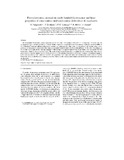Photochromism, anomalous multi-banded fluorescence and laser properties of some amino- and tosyl-amino derivatives of oxadiazole
Date
2006Author
Nijegorodov, N
Zvolinski, V
Luhanga, P V C
Mabbs, R
Ahmad, J
Publisher
Elsevier Science Ltd. www.elsevier.com/locate/saaType
ArticleMetadata
Show full item recordAbstract
The multi-banded fluorescence and laser properties of 11 new amino- and tosylamino derivatives of 2,5-di(phenyl)-1,3,4-oxadiazole and
oxadiazole in various solvents at 293K are reported. All the compounds investigated possess intra-molecular hydrogen quasi-bond (IHB) of
4.6–5.2 kcal mol−1 in the ground state. In the excited state they can undergo protolytic dissociation or intra-molecular photon-initiated transfer of
proton and reveal anomalous fluorescence which cannot be explained within the framework of the Kasha and Kasha–Vavilov rules. Depending upon
the excitation wavelength, solvent, concentration and pH of the medium, the compounds studied show a single, double, triple or even a four-banded
fluorescence, which has not been reported earlier. The nature of multi-banded fluorescence is explained in terms of the possible photochromic
processes in excited states. Quantum yields and decay times of the different fluorescence bands are reported. Anomalous dependence of quantum
yield upon concentration of the solution is observed. Laser properties of the compounds studied are carefully tested. Laser action based on the
fluorescence of the so-called bi-radical molecules is reported. Various possible arrangements of singlet and triplet levels of compounds investigated
are discussed.

